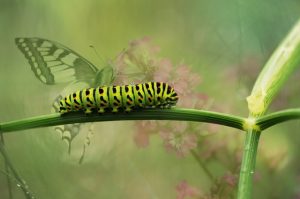This spring, take the next step to protect our beneficial pollinators by planting host plants! Many sustainability-minded folks already know how important Milkweed is to Monarchs. But why is it so important? It is a great nectar source but its real impact is as a host plant. Host plants are food sources for the larvae of our pollinators – the caterpillars of our butterflies and moths. The most obvious importance of happily fed caterpillars is that they can then metamorphose into the beautiful butterflies we invite into our garden. But a second, very important, role of caterpillars is as bird food. 80% of birds feed their young almost exclusively caterpillars! Without happily fed caterpillars we won’t have the beautiful diversity of birds in our backyards.
So, what are some good host plants you can plant in your yard?
- Milkweed is always a good choice especially since between 1976-2015, we lost 96.4% of our Monarch population. I recommend the Butterfly Milkweed and Swamp Milkweed because they tend not to wander like the Common Milkweed. Fair warning though that Butterfly Milkweed can be a little tough to establish so you may need to replant or try different areas in your yard if at first you don’t succeed.
- If you have room for a small tree somewhere in your yard, I would also suggest the semi-evergreen Sweet Bay Magnolia as a host plant for Tiger Swallowtails. An easily found nativar is ‘Moonglow’ which reaches 15-35’ tall and 10-20’ wide. This Magnolia does like moisture so locate it in a low or wet point in your yard and take care to water it in times of drought.
- If you want to try a cool new vine, try Dutchman’s Pipe to attract Pipevine Swallowtails. Reaching 20-30’ tall/long and 5-10’wide, it is a great choice for pergolas and fences. The plant is named for the funky flowers resembling its namesake Dutchman’s pipe in May and June.
 One thing to remember when planting host plants is that the goal for planting these plants is we want them to be food. So, you will have to embrace some plants with imperfect foliage or place them somewhere in your yard where some munched-on leaves won’t be noticed or bother you.
One thing to remember when planting host plants is that the goal for planting these plants is we want them to be food. So, you will have to embrace some plants with imperfect foliage or place them somewhere in your yard where some munched-on leaves won’t be noticed or bother you.
There are lots of great sources out there that let you know exactly what plants to plant for various butterflies and moths. Here are a couple of my favorites:
Missouri Botanical Garden – Native Plants to Attract Butterflies
Pollinator Plants – Midwest Region
Article written by: Rebecca Eisele, Landscape Designer
Rebecca is our Landscape Design extraordinaire. She is current acting Vice President of the Landscape Nursery Association of Greater St. Louis and is an inaugural Board Member of the Missouri Green Industry Alliance. Is is also active with Grow Native!, a plant education program of the Missouri Prairie Foundation.
For additional reading – Help Bring Back Pollinators, published in our blog in Spring, 2017.
